The Global Financial Crisis: Impacts on Developing Economies
VerifiedAdded on 2020/07/22
|69
|20633
|69
Report
AI Summary
This report provides a comprehensive analysis of the Global Financial Crisis (GFC) and its multifaceted impacts on developing countries. The study examines the direct and indirect influences of the crisis, focusing on key economic factors such as employment, GDP growth, economic rates, stock markets, and inflation. It explores various economic theories and utilizes data collection to provide an authenticated and adequate understanding of the crisis's effects. The research critically assesses the severe impacts on Asian, African, and other developing nations, identifying early warning indicators and suggesting policy choices to mitigate future challenges. The study also incorporates secondary research on small-scale industries in the UK, revealing the crisis's impact on import rates, commodity prices, inflation, unemployment, and poverty. The report emphasizes the importance of enhancing small-scale enterprises to improve GDP rates and reduce imports. Furthermore, it suggests strategies for managing monetary systems and ensuring equal employment opportunities. The conclusion highlights the study's significance for policymakers and regulatory authorities in assessing the causes and consequences of the GFC, offering valuable insights for economic stability and growth in developing nations.

The Global Financial Crisis and Its
Impact on Developing Countries
Impact on Developing Countries
Paraphrase This Document
Need a fresh take? Get an instant paraphrase of this document with our AI Paraphraser
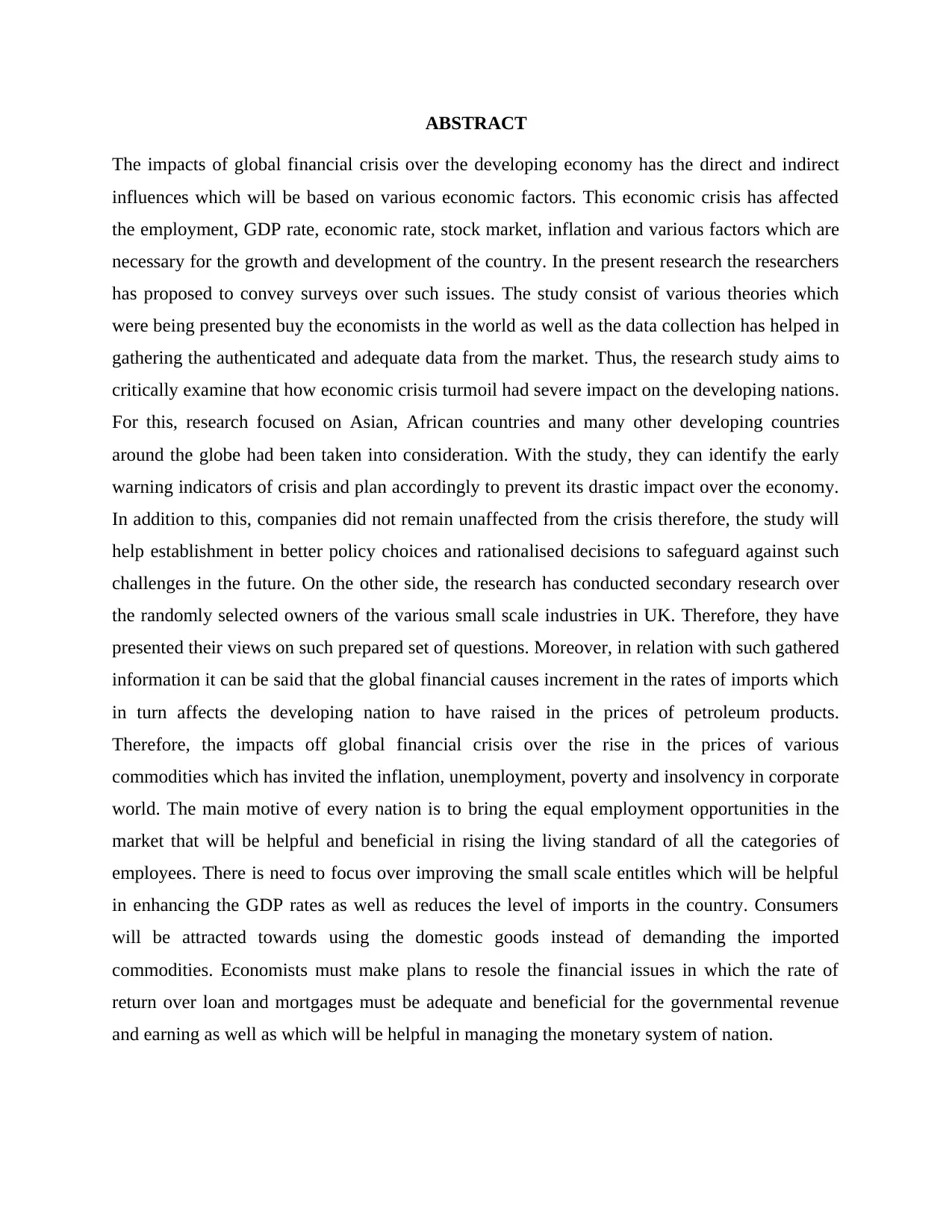
ABSTRACT
The impacts of global financial crisis over the developing economy has the direct and indirect
influences which will be based on various economic factors. This economic crisis has affected
the employment, GDP rate, economic rate, stock market, inflation and various factors which are
necessary for the growth and development of the country. In the present research the researchers
has proposed to convey surveys over such issues. The study consist of various theories which
were being presented buy the economists in the world as well as the data collection has helped in
gathering the authenticated and adequate data from the market. Thus, the research study aims to
critically examine that how economic crisis turmoil had severe impact on the developing nations.
For this, research focused on Asian, African countries and many other developing countries
around the globe had been taken into consideration. With the study, they can identify the early
warning indicators of crisis and plan accordingly to prevent its drastic impact over the economy.
In addition to this, companies did not remain unaffected from the crisis therefore, the study will
help establishment in better policy choices and rationalised decisions to safeguard against such
challenges in the future. On the other side, the research has conducted secondary research over
the randomly selected owners of the various small scale industries in UK. Therefore, they have
presented their views on such prepared set of questions. Moreover, in relation with such gathered
information it can be said that the global financial causes increment in the rates of imports which
in turn affects the developing nation to have raised in the prices of petroleum products.
Therefore, the impacts off global financial crisis over the rise in the prices of various
commodities which has invited the inflation, unemployment, poverty and insolvency in corporate
world. The main motive of every nation is to bring the equal employment opportunities in the
market that will be helpful and beneficial in rising the living standard of all the categories of
employees. There is need to focus over improving the small scale entitles which will be helpful
in enhancing the GDP rates as well as reduces the level of imports in the country. Consumers
will be attracted towards using the domestic goods instead of demanding the imported
commodities. Economists must make plans to resole the financial issues in which the rate of
return over loan and mortgages must be adequate and beneficial for the governmental revenue
and earning as well as which will be helpful in managing the monetary system of nation.
The impacts of global financial crisis over the developing economy has the direct and indirect
influences which will be based on various economic factors. This economic crisis has affected
the employment, GDP rate, economic rate, stock market, inflation and various factors which are
necessary for the growth and development of the country. In the present research the researchers
has proposed to convey surveys over such issues. The study consist of various theories which
were being presented buy the economists in the world as well as the data collection has helped in
gathering the authenticated and adequate data from the market. Thus, the research study aims to
critically examine that how economic crisis turmoil had severe impact on the developing nations.
For this, research focused on Asian, African countries and many other developing countries
around the globe had been taken into consideration. With the study, they can identify the early
warning indicators of crisis and plan accordingly to prevent its drastic impact over the economy.
In addition to this, companies did not remain unaffected from the crisis therefore, the study will
help establishment in better policy choices and rationalised decisions to safeguard against such
challenges in the future. On the other side, the research has conducted secondary research over
the randomly selected owners of the various small scale industries in UK. Therefore, they have
presented their views on such prepared set of questions. Moreover, in relation with such gathered
information it can be said that the global financial causes increment in the rates of imports which
in turn affects the developing nation to have raised in the prices of petroleum products.
Therefore, the impacts off global financial crisis over the rise in the prices of various
commodities which has invited the inflation, unemployment, poverty and insolvency in corporate
world. The main motive of every nation is to bring the equal employment opportunities in the
market that will be helpful and beneficial in rising the living standard of all the categories of
employees. There is need to focus over improving the small scale entitles which will be helpful
in enhancing the GDP rates as well as reduces the level of imports in the country. Consumers
will be attracted towards using the domestic goods instead of demanding the imported
commodities. Economists must make plans to resole the financial issues in which the rate of
return over loan and mortgages must be adequate and beneficial for the governmental revenue
and earning as well as which will be helpful in managing the monetary system of nation.
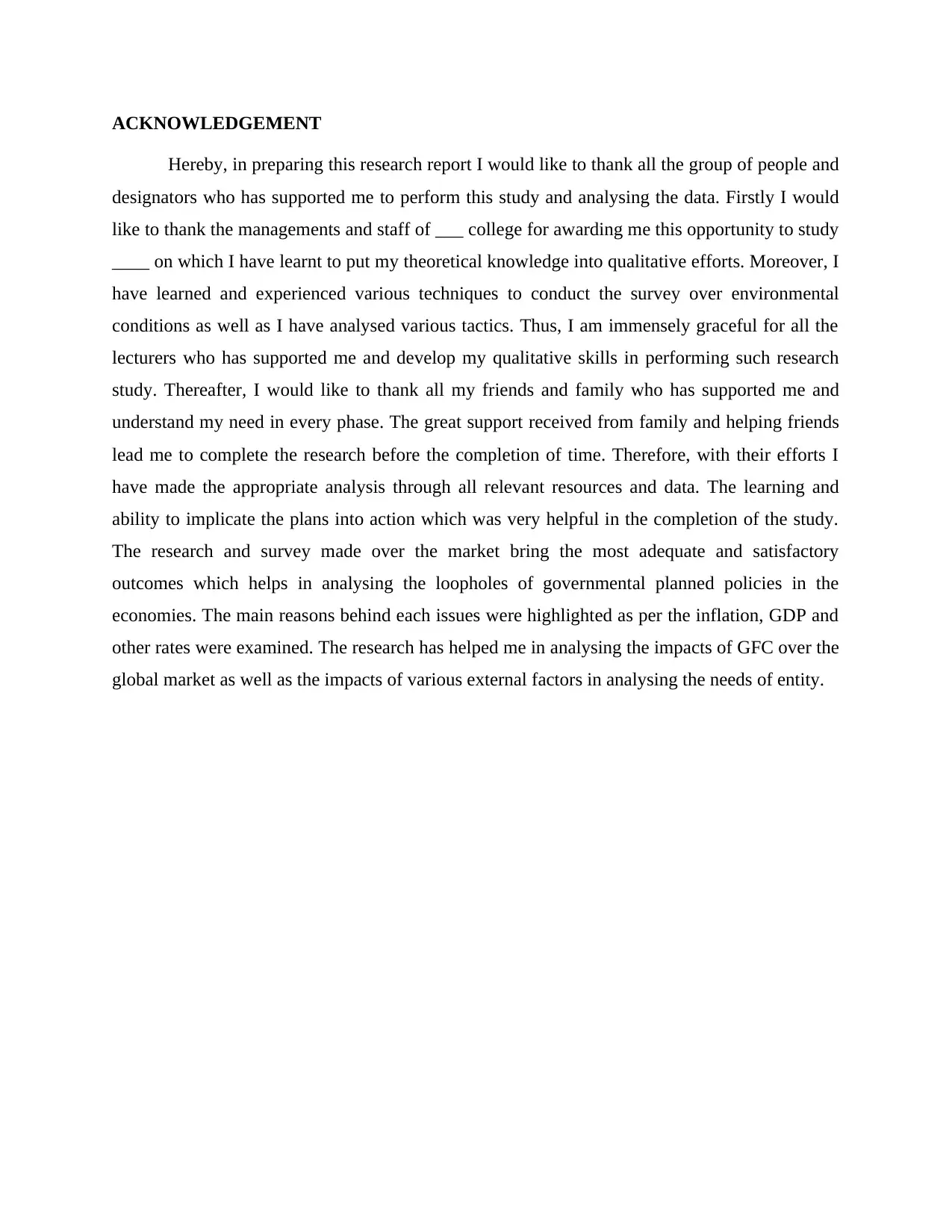
ACKNOWLEDGEMENT
Hereby, in preparing this research report I would like to thank all the group of people and
designators who has supported me to perform this study and analysing the data. Firstly I would
like to thank the managements and staff of ___ college for awarding me this opportunity to study
____ on which I have learnt to put my theoretical knowledge into qualitative efforts. Moreover, I
have learned and experienced various techniques to conduct the survey over environmental
conditions as well as I have analysed various tactics. Thus, I am immensely graceful for all the
lecturers who has supported me and develop my qualitative skills in performing such research
study. Thereafter, I would like to thank all my friends and family who has supported me and
understand my need in every phase. The great support received from family and helping friends
lead me to complete the research before the completion of time. Therefore, with their efforts I
have made the appropriate analysis through all relevant resources and data. The learning and
ability to implicate the plans into action which was very helpful in the completion of the study.
The research and survey made over the market bring the most adequate and satisfactory
outcomes which helps in analysing the loopholes of governmental planned policies in the
economies. The main reasons behind each issues were highlighted as per the inflation, GDP and
other rates were examined. The research has helped me in analysing the impacts of GFC over the
global market as well as the impacts of various external factors in analysing the needs of entity.
Hereby, in preparing this research report I would like to thank all the group of people and
designators who has supported me to perform this study and analysing the data. Firstly I would
like to thank the managements and staff of ___ college for awarding me this opportunity to study
____ on which I have learnt to put my theoretical knowledge into qualitative efforts. Moreover, I
have learned and experienced various techniques to conduct the survey over environmental
conditions as well as I have analysed various tactics. Thus, I am immensely graceful for all the
lecturers who has supported me and develop my qualitative skills in performing such research
study. Thereafter, I would like to thank all my friends and family who has supported me and
understand my need in every phase. The great support received from family and helping friends
lead me to complete the research before the completion of time. Therefore, with their efforts I
have made the appropriate analysis through all relevant resources and data. The learning and
ability to implicate the plans into action which was very helpful in the completion of the study.
The research and survey made over the market bring the most adequate and satisfactory
outcomes which helps in analysing the loopholes of governmental planned policies in the
economies. The main reasons behind each issues were highlighted as per the inflation, GDP and
other rates were examined. The research has helped me in analysing the impacts of GFC over the
global market as well as the impacts of various external factors in analysing the needs of entity.
⊘ This is a preview!⊘
Do you want full access?
Subscribe today to unlock all pages.

Trusted by 1+ million students worldwide
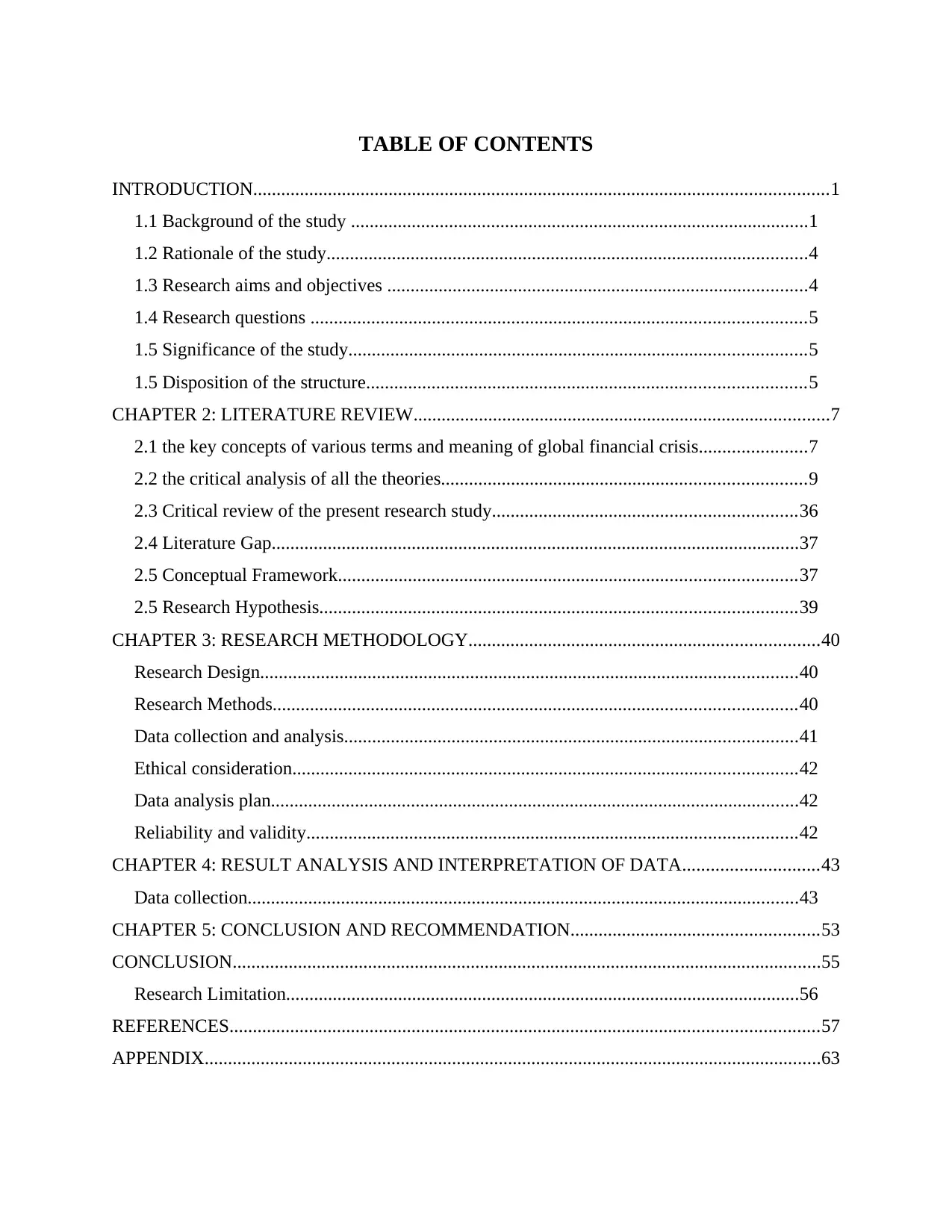
TABLE OF CONTENTS
INTRODUCTION...........................................................................................................................1
1.1 Background of the study ..................................................................................................1
1.2 Rationale of the study.......................................................................................................4
1.3 Research aims and objectives ..........................................................................................4
1.4 Research questions ..........................................................................................................5
1.5 Significance of the study..................................................................................................5
1.5 Disposition of the structure..............................................................................................5
CHAPTER 2: LITERATURE REVIEW.........................................................................................7
2.1 the key concepts of various terms and meaning of global financial crisis.......................7
2.2 the critical analysis of all the theories..............................................................................9
2.3 Critical review of the present research study.................................................................36
2.4 Literature Gap.................................................................................................................37
2.5 Conceptual Framework..................................................................................................37
2.5 Research Hypothesis......................................................................................................39
CHAPTER 3: RESEARCH METHODOLOGY...........................................................................40
Research Design...................................................................................................................40
Research Methods................................................................................................................40
Data collection and analysis.................................................................................................41
Ethical consideration............................................................................................................42
Data analysis plan.................................................................................................................42
Reliability and validity.........................................................................................................42
CHAPTER 4: RESULT ANALYSIS AND INTERPRETATION OF DATA.............................43
Data collection......................................................................................................................43
CHAPTER 5: CONCLUSION AND RECOMMENDATION.....................................................53
CONCLUSION..............................................................................................................................55
Research Limitation..............................................................................................................56
REFERENCES..............................................................................................................................57
APPENDIX....................................................................................................................................63
INTRODUCTION...........................................................................................................................1
1.1 Background of the study ..................................................................................................1
1.2 Rationale of the study.......................................................................................................4
1.3 Research aims and objectives ..........................................................................................4
1.4 Research questions ..........................................................................................................5
1.5 Significance of the study..................................................................................................5
1.5 Disposition of the structure..............................................................................................5
CHAPTER 2: LITERATURE REVIEW.........................................................................................7
2.1 the key concepts of various terms and meaning of global financial crisis.......................7
2.2 the critical analysis of all the theories..............................................................................9
2.3 Critical review of the present research study.................................................................36
2.4 Literature Gap.................................................................................................................37
2.5 Conceptual Framework..................................................................................................37
2.5 Research Hypothesis......................................................................................................39
CHAPTER 3: RESEARCH METHODOLOGY...........................................................................40
Research Design...................................................................................................................40
Research Methods................................................................................................................40
Data collection and analysis.................................................................................................41
Ethical consideration............................................................................................................42
Data analysis plan.................................................................................................................42
Reliability and validity.........................................................................................................42
CHAPTER 4: RESULT ANALYSIS AND INTERPRETATION OF DATA.............................43
Data collection......................................................................................................................43
CHAPTER 5: CONCLUSION AND RECOMMENDATION.....................................................53
CONCLUSION..............................................................................................................................55
Research Limitation..............................................................................................................56
REFERENCES..............................................................................................................................57
APPENDIX....................................................................................................................................63
Paraphrase This Document
Need a fresh take? Get an instant paraphrase of this document with our AI Paraphraser

ILLUSTRATION INDEX
Illustration 1: Global per capita income during global financial crisis............................................3
Illustration 2: GDP growth of UK, Australia and USA during GFC...............................................4
Illustration 3: Global financial crisis impacts on UK inflation......................................................10
Illustration 4: Inflation in Australia...............................................................................................11
Illustration 5: Inflation in Indonesia..............................................................................................12
Illustration 6: Example of Hyper inflation in Zimbabwe...............................................................14
Illustration 7: Monetarist theory of inflation in US and UK..........................................................15
Illustration 8: Demand pull inflation in UK...................................................................................17
Illustration 9: UK inflation during Global Financial Crisis...........................................................19
Illustration 10: Inflation impacts over Sri Lanka...........................................................................20
Illustration 11: Impacts of global financial crisis over employment.............................................22
Illustration 12: Unemployment rate in UK....................................................................................23
Illustration 13: Unemployment in Australia..................................................................................24
Illustration 14: UK GDP rate during Global financial crisis.........................................................31
Illustration 15: Global financial crisis............................................................................................38
Illustration 1: Global per capita income during global financial crisis............................................3
Illustration 2: GDP growth of UK, Australia and USA during GFC...............................................4
Illustration 3: Global financial crisis impacts on UK inflation......................................................10
Illustration 4: Inflation in Australia...............................................................................................11
Illustration 5: Inflation in Indonesia..............................................................................................12
Illustration 6: Example of Hyper inflation in Zimbabwe...............................................................14
Illustration 7: Monetarist theory of inflation in US and UK..........................................................15
Illustration 8: Demand pull inflation in UK...................................................................................17
Illustration 9: UK inflation during Global Financial Crisis...........................................................19
Illustration 10: Inflation impacts over Sri Lanka...........................................................................20
Illustration 11: Impacts of global financial crisis over employment.............................................22
Illustration 12: Unemployment rate in UK....................................................................................23
Illustration 13: Unemployment in Australia..................................................................................24
Illustration 14: UK GDP rate during Global financial crisis.........................................................31
Illustration 15: Global financial crisis............................................................................................38

INTRODUCTION
1.1 Background of the study
The Global Financial Crisis (GFC) begun in July 2007 when investors lost their
confidence in sub-prime mortgage value that raised liquidity crunch, in turn, US Federal Bank
injected massive amount of money into the financial markets Rey (2015). By 2008, the situation
became worse since Great Depression due to crashed stock markets caused by extreme volatility.
As per Millennium Development Goals, the deepened global recession, highly volatile
commodity prices and rising level of unemployment during 2008-2009 had severely impacted on
the progress towards eradication of poverty. In the mid of 2008, rapidly increasing food prices
culminated exceptional shock in the prices and brought extreme poverty Stuckler and et.al.,
(2009). It deteriorated the growth prospectus of the developing nations and slowed the progress
towards reduction in poverty. Its recovery was dependent on the effective policy actions so as to
rebuild confidence of the people in the financial system. In advanced economies, developing
countries play an important role in enhancing the possible future growth outlook, bringing
macroeconomic stability and strengthening the global financial system Peek and Rosengren,
(2000).
FDI rates
Years Malaysia Argentina Brazil China
2000 3787631578.94737 10418314339.1428 32994718699.75 42095300000
2001 553947368.421053 2166136829.76399 23225846372.251 47053000000
2002 3192894736.8421 2148910000 16586600193.114 53073618897.4036
2003 3218947368.42105 1652010000 10123013670.9901 57900937467.3864
2004 4376052631.57894 4124710000 18181190855.2842 68117272181.2194
2005 3924786634.73868 5265250000 15459981604.1196 104108693867.085
2006 7690731245.66746 5537340000 19378093068.2773 124082035618.506
2007 9071369834.83859 6473150000 44579492463.6336 156249335203.202
2008 7572512432.33634 9725560000 50716402711.4787 171534650311.569
2009 114664434.562276 4017158924.88408 31480932200 131057052869.5
2010 10885614182.2081 11332718626.4345 88452079263.99 243703434558.178
2011 15119371191.19 10839930944.6815 101157817518.34 280072219149.935
2012 8895774251.02491 15323933916.8241 86606502980.75 241213868161.42
1
1.1 Background of the study
The Global Financial Crisis (GFC) begun in July 2007 when investors lost their
confidence in sub-prime mortgage value that raised liquidity crunch, in turn, US Federal Bank
injected massive amount of money into the financial markets Rey (2015). By 2008, the situation
became worse since Great Depression due to crashed stock markets caused by extreme volatility.
As per Millennium Development Goals, the deepened global recession, highly volatile
commodity prices and rising level of unemployment during 2008-2009 had severely impacted on
the progress towards eradication of poverty. In the mid of 2008, rapidly increasing food prices
culminated exceptional shock in the prices and brought extreme poverty Stuckler and et.al.,
(2009). It deteriorated the growth prospectus of the developing nations and slowed the progress
towards reduction in poverty. Its recovery was dependent on the effective policy actions so as to
rebuild confidence of the people in the financial system. In advanced economies, developing
countries play an important role in enhancing the possible future growth outlook, bringing
macroeconomic stability and strengthening the global financial system Peek and Rosengren,
(2000).
FDI rates
Years Malaysia Argentina Brazil China
2000 3787631578.94737 10418314339.1428 32994718699.75 42095300000
2001 553947368.421053 2166136829.76399 23225846372.251 47053000000
2002 3192894736.8421 2148910000 16586600193.114 53073618897.4036
2003 3218947368.42105 1652010000 10123013670.9901 57900937467.3864
2004 4376052631.57894 4124710000 18181190855.2842 68117272181.2194
2005 3924786634.73868 5265250000 15459981604.1196 104108693867.085
2006 7690731245.66746 5537340000 19378093068.2773 124082035618.506
2007 9071369834.83859 6473150000 44579492463.6336 156249335203.202
2008 7572512432.33634 9725560000 50716402711.4787 171534650311.569
2009 114664434.562276 4017158924.88408 31480932200 131057052869.5
2010 10885614182.2081 11332718626.4345 88452079263.99 243703434558.178
2011 15119371191.19 10839930944.6815 101157817518.34 280072219149.935
2012 8895774251.02491 15323933916.8241 86606502980.75 241213868161.42
1
⊘ This is a preview!⊘
Do you want full access?
Subscribe today to unlock all pages.

Trusted by 1+ million students worldwide

2013 11296278695.655 9821661858.15874 69686087840.68 290928431467.003
2014 10619431769.7803 5065335541.96486 97175059297.28 268097181064.335
2015 9857162232.86717 11758994011.286 74718044773.96 242489331627.399
2016 13515796131.0828 3260164341.77393 78167247014.61 170556525654.03
2000 2001 2002 2003 2004 2005 2006 2007 2008 2009 2010 2011 2012 2013 2014 2015 2016
0
50000000000
100000000000
150000000000
200000000000
250000000000
300000000000
350000000000
Malaysia
Argentina
Brazil
China
During the period of crisis, developing nations had experienced an economic boom
fuelled by a mixture of numerous factors; exceptional financing, sharply rising commodity prices
and huge flows of remittances. With the occurrence of financial crisis, country had faced diverse
pressure in the area of employment, growth and food security Hattori, Shim and Sugihara,
(2018). This had made it essential for the policymakers to rethink on the micro as well as macro-
economic policies. Till the eruption of the crisis, commodity prices had continued to increase
Sen and Grown, (2013). It had both the positive and negative impact on the developing nations.
Increasing commodity prices together with the foreign exchange reserves helped nations in
attracting more capital even after sub-prime crisis however, remittance experienced considerable
economic downturn Held and et.al., (2000).
2
2014 10619431769.7803 5065335541.96486 97175059297.28 268097181064.335
2015 9857162232.86717 11758994011.286 74718044773.96 242489331627.399
2016 13515796131.0828 3260164341.77393 78167247014.61 170556525654.03
2000 2001 2002 2003 2004 2005 2006 2007 2008 2009 2010 2011 2012 2013 2014 2015 2016
0
50000000000
100000000000
150000000000
200000000000
250000000000
300000000000
350000000000
Malaysia
Argentina
Brazil
China
During the period of crisis, developing nations had experienced an economic boom
fuelled by a mixture of numerous factors; exceptional financing, sharply rising commodity prices
and huge flows of remittances. With the occurrence of financial crisis, country had faced diverse
pressure in the area of employment, growth and food security Hattori, Shim and Sugihara,
(2018). This had made it essential for the policymakers to rethink on the micro as well as macro-
economic policies. Till the eruption of the crisis, commodity prices had continued to increase
Sen and Grown, (2013). It had both the positive and negative impact on the developing nations.
Increasing commodity prices together with the foreign exchange reserves helped nations in
attracting more capital even after sub-prime crisis however, remittance experienced considerable
economic downturn Held and et.al., (2000).
2
Paraphrase This Document
Need a fresh take? Get an instant paraphrase of this document with our AI Paraphraser
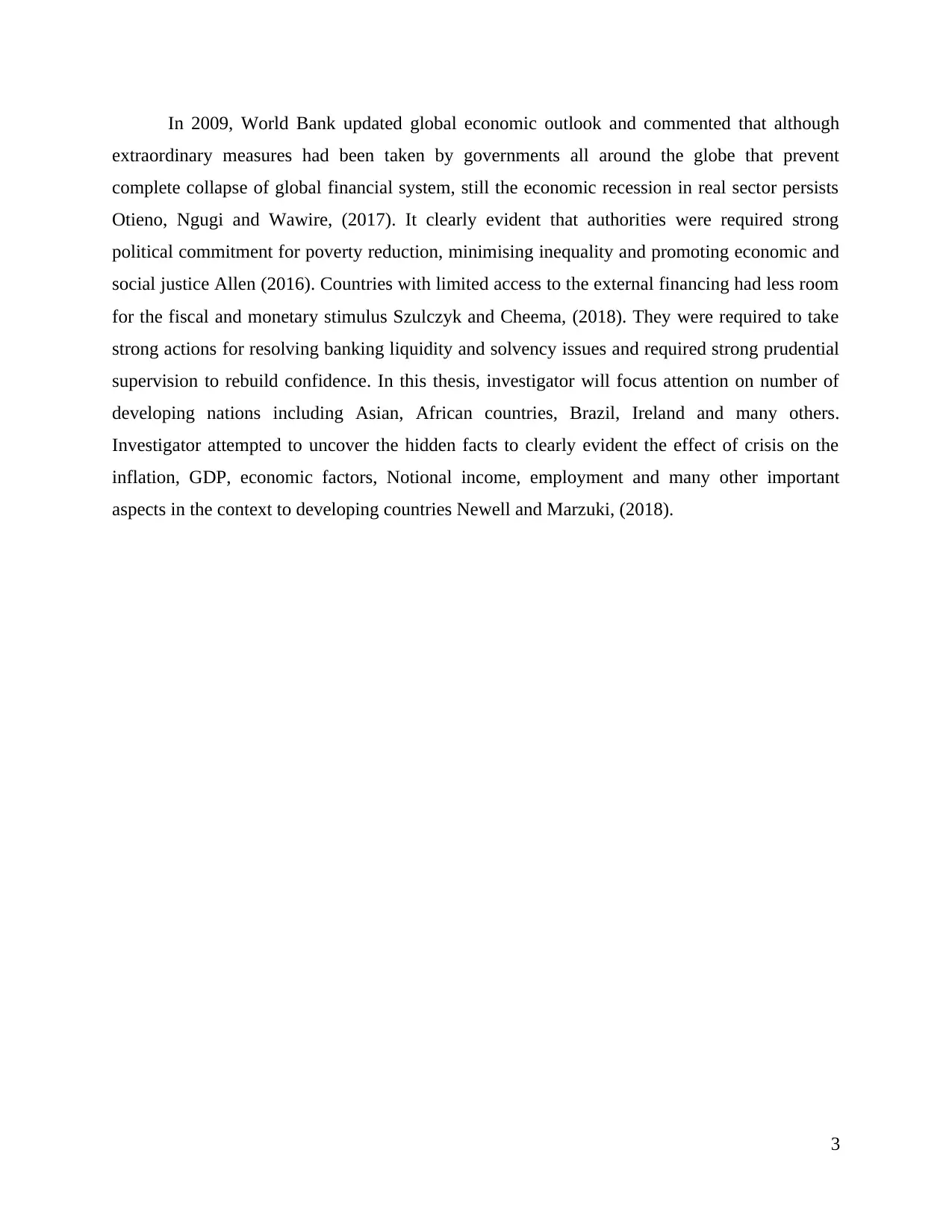
In 2009, World Bank updated global economic outlook and commented that although
extraordinary measures had been taken by governments all around the globe that prevent
complete collapse of global financial system, still the economic recession in real sector persists
Otieno, Ngugi and Wawire, (2017). It clearly evident that authorities were required strong
political commitment for poverty reduction, minimising inequality and promoting economic and
social justice Allen (2016). Countries with limited access to the external financing had less room
for the fiscal and monetary stimulus Szulczyk and Cheema, (2018). They were required to take
strong actions for resolving banking liquidity and solvency issues and required strong prudential
supervision to rebuild confidence. In this thesis, investigator will focus attention on number of
developing nations including Asian, African countries, Brazil, Ireland and many others.
Investigator attempted to uncover the hidden facts to clearly evident the effect of crisis on the
inflation, GDP, economic factors, Notional income, employment and many other important
aspects in the context to developing countries Newell and Marzuki, (2018).
3
extraordinary measures had been taken by governments all around the globe that prevent
complete collapse of global financial system, still the economic recession in real sector persists
Otieno, Ngugi and Wawire, (2017). It clearly evident that authorities were required strong
political commitment for poverty reduction, minimising inequality and promoting economic and
social justice Allen (2016). Countries with limited access to the external financing had less room
for the fiscal and monetary stimulus Szulczyk and Cheema, (2018). They were required to take
strong actions for resolving banking liquidity and solvency issues and required strong prudential
supervision to rebuild confidence. In this thesis, investigator will focus attention on number of
developing nations including Asian, African countries, Brazil, Ireland and many others.
Investigator attempted to uncover the hidden facts to clearly evident the effect of crisis on the
inflation, GDP, economic factors, Notional income, employment and many other important
aspects in the context to developing countries Newell and Marzuki, (2018).
3
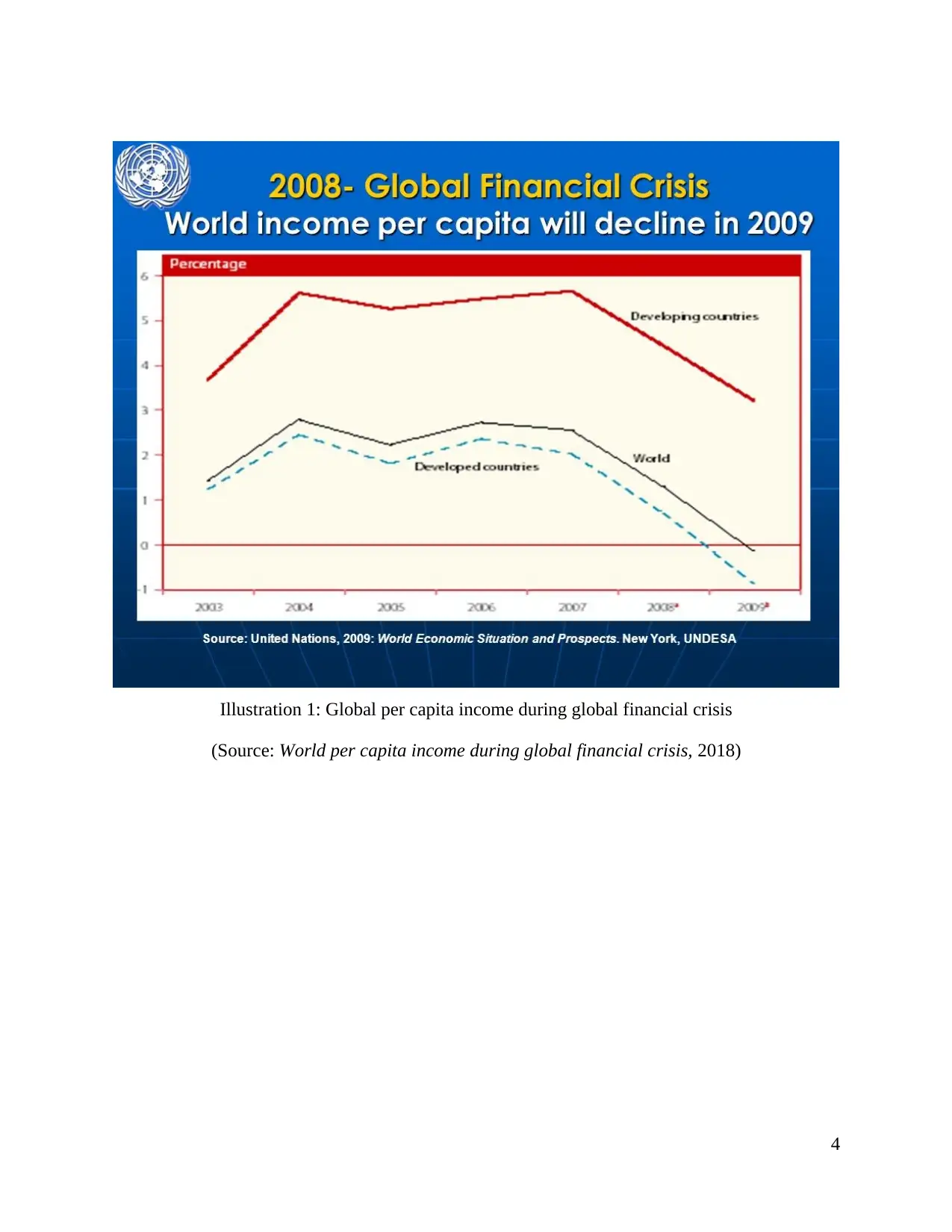
4
Illustration 1: Global per capita income during global financial crisis
(Source: World per capita income during global financial crisis, 2018)
Illustration 1: Global per capita income during global financial crisis
(Source: World per capita income during global financial crisis, 2018)
⊘ This is a preview!⊘
Do you want full access?
Subscribe today to unlock all pages.

Trusted by 1+ million students worldwide

Illustration 2: GDP growth of UK, Australia and USA during GFC
(Source: Consumer confidence tells us 'the vibe' - that's about it, 2012)
1.2 Rationale of the study
During crisis, economies slumped down and despite governmental efforts, it had severe
adverse consequences on the developing nations. In the past, number of scholars had shown their
interest in the area and investigated crisis, its reasons and its impact on both the developed and
developing nations Tiwari, Albulescu and Yoon, (2017). However, all the study had narrowed
scope and to the best of scholar’s knowledge, none of the study had investigated the impact of
crisis on developing countries thoroughly. Thus, the research study aims to critically examine
that how economic crisis turmoil had severe impact on the developing nations. For this, research
focused on Asian, African countries and many other developing countries around the globe had
been taken into consideration. The paper aims to investigate the impact of crisis on developing
nations in a critical manner including key focus on Inflation, Employment, GDP rate, Stock
exchange, National income and Economic ratio.
1.3 Research aims and objectives
The aim of the thesis is to investigate that how turmoil during crisis in the Global
Financial System had severely affected the developing nations all around the world.
Research objectives:
1. To critically examine the concept of Global Financial Crisis
2. To explore the key factors how they contributed towards crisis
5
(Source: Consumer confidence tells us 'the vibe' - that's about it, 2012)
1.2 Rationale of the study
During crisis, economies slumped down and despite governmental efforts, it had severe
adverse consequences on the developing nations. In the past, number of scholars had shown their
interest in the area and investigated crisis, its reasons and its impact on both the developed and
developing nations Tiwari, Albulescu and Yoon, (2017). However, all the study had narrowed
scope and to the best of scholar’s knowledge, none of the study had investigated the impact of
crisis on developing countries thoroughly. Thus, the research study aims to critically examine
that how economic crisis turmoil had severe impact on the developing nations. For this, research
focused on Asian, African countries and many other developing countries around the globe had
been taken into consideration. The paper aims to investigate the impact of crisis on developing
nations in a critical manner including key focus on Inflation, Employment, GDP rate, Stock
exchange, National income and Economic ratio.
1.3 Research aims and objectives
The aim of the thesis is to investigate that how turmoil during crisis in the Global
Financial System had severely affected the developing nations all around the world.
Research objectives:
1. To critically examine the concept of Global Financial Crisis
2. To explore the key factors how they contributed towards crisis
5
Paraphrase This Document
Need a fresh take? Get an instant paraphrase of this document with our AI Paraphraser
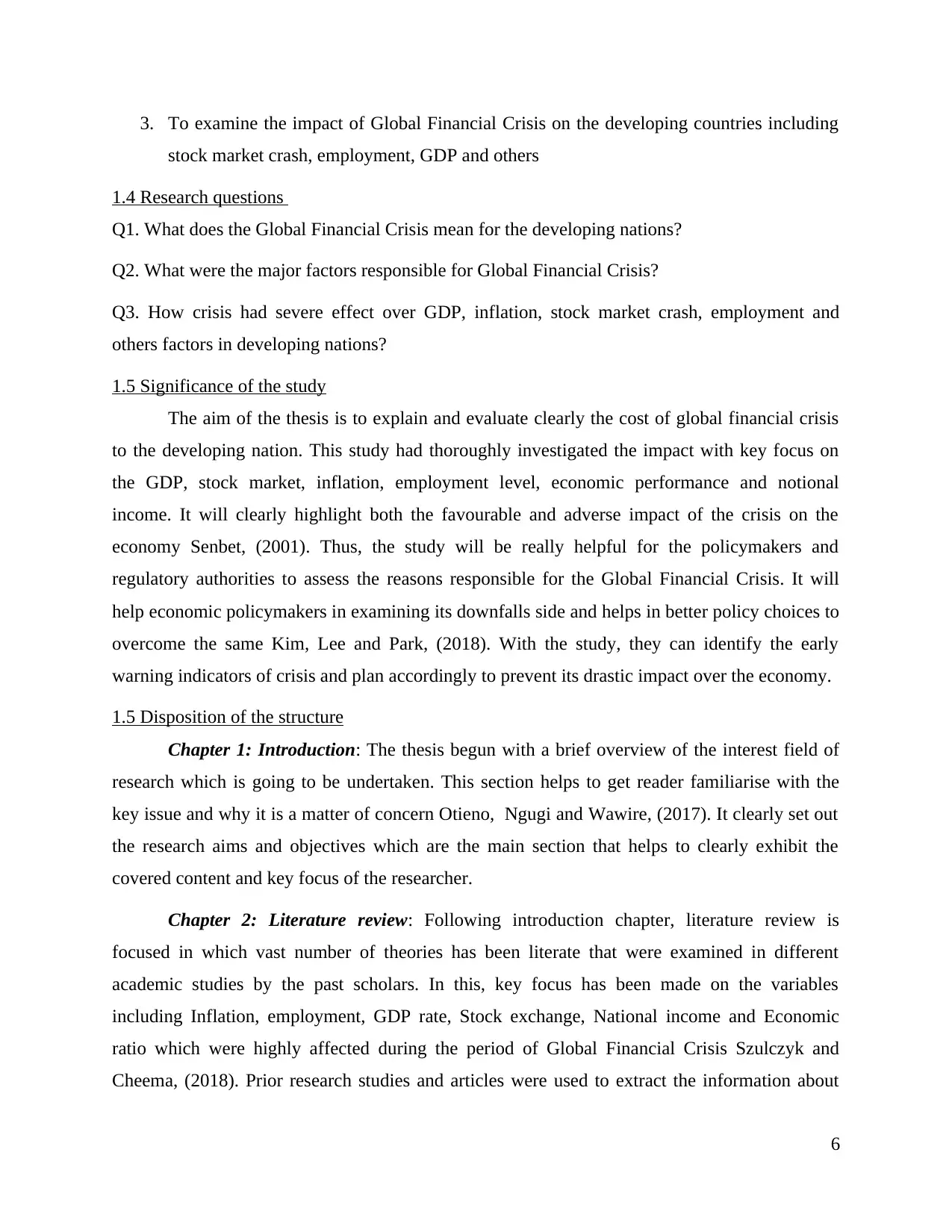
3. To examine the impact of Global Financial Crisis on the developing countries including
stock market crash, employment, GDP and others
1.4 Research questions
Q1. What does the Global Financial Crisis mean for the developing nations?
Q2. What were the major factors responsible for Global Financial Crisis?
Q3. How crisis had severe effect over GDP, inflation, stock market crash, employment and
others factors in developing nations?
1.5 Significance of the study
The aim of the thesis is to explain and evaluate clearly the cost of global financial crisis
to the developing nation. This study had thoroughly investigated the impact with key focus on
the GDP, stock market, inflation, employment level, economic performance and notional
income. It will clearly highlight both the favourable and adverse impact of the crisis on the
economy Senbet, (2001). Thus, the study will be really helpful for the policymakers and
regulatory authorities to assess the reasons responsible for the Global Financial Crisis. It will
help economic policymakers in examining its downfalls side and helps in better policy choices to
overcome the same Kim, Lee and Park, (2018). With the study, they can identify the early
warning indicators of crisis and plan accordingly to prevent its drastic impact over the economy.
1.5 Disposition of the structure
Chapter 1: Introduction: The thesis begun with a brief overview of the interest field of
research which is going to be undertaken. This section helps to get reader familiarise with the
key issue and why it is a matter of concern Otieno, Ngugi and Wawire, (2017). It clearly set out
the research aims and objectives which are the main section that helps to clearly exhibit the
covered content and key focus of the researcher.
Chapter 2: Literature review: Following introduction chapter, literature review is
focused in which vast number of theories has been literate that were examined in different
academic studies by the past scholars. In this, key focus has been made on the variables
including Inflation, employment, GDP rate, Stock exchange, National income and Economic
ratio which were highly affected during the period of Global Financial Crisis Szulczyk and
Cheema, (2018). Prior research studies and articles were used to extract the information about
6
stock market crash, employment, GDP and others
1.4 Research questions
Q1. What does the Global Financial Crisis mean for the developing nations?
Q2. What were the major factors responsible for Global Financial Crisis?
Q3. How crisis had severe effect over GDP, inflation, stock market crash, employment and
others factors in developing nations?
1.5 Significance of the study
The aim of the thesis is to explain and evaluate clearly the cost of global financial crisis
to the developing nation. This study had thoroughly investigated the impact with key focus on
the GDP, stock market, inflation, employment level, economic performance and notional
income. It will clearly highlight both the favourable and adverse impact of the crisis on the
economy Senbet, (2001). Thus, the study will be really helpful for the policymakers and
regulatory authorities to assess the reasons responsible for the Global Financial Crisis. It will
help economic policymakers in examining its downfalls side and helps in better policy choices to
overcome the same Kim, Lee and Park, (2018). With the study, they can identify the early
warning indicators of crisis and plan accordingly to prevent its drastic impact over the economy.
1.5 Disposition of the structure
Chapter 1: Introduction: The thesis begun with a brief overview of the interest field of
research which is going to be undertaken. This section helps to get reader familiarise with the
key issue and why it is a matter of concern Otieno, Ngugi and Wawire, (2017). It clearly set out
the research aims and objectives which are the main section that helps to clearly exhibit the
covered content and key focus of the researcher.
Chapter 2: Literature review: Following introduction chapter, literature review is
focused in which vast number of theories has been literate that were examined in different
academic studies by the past scholars. In this, key focus has been made on the variables
including Inflation, employment, GDP rate, Stock exchange, National income and Economic
ratio which were highly affected during the period of Global Financial Crisis Szulczyk and
Cheema, (2018). Prior research studies and articles were used to extract the information about
6
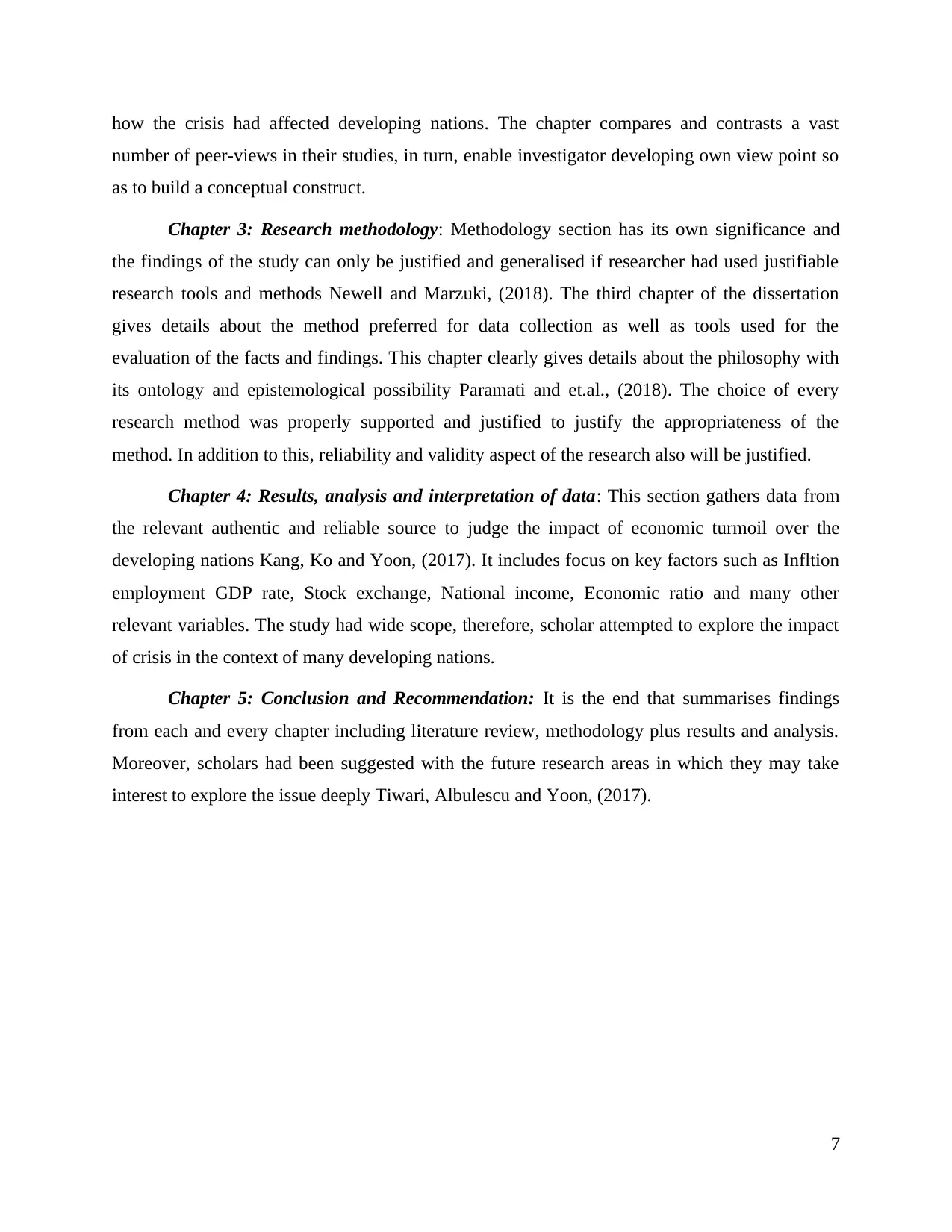
how the crisis had affected developing nations. The chapter compares and contrasts a vast
number of peer-views in their studies, in turn, enable investigator developing own view point so
as to build a conceptual construct.
Chapter 3: Research methodology: Methodology section has its own significance and
the findings of the study can only be justified and generalised if researcher had used justifiable
research tools and methods Newell and Marzuki, (2018). The third chapter of the dissertation
gives details about the method preferred for data collection as well as tools used for the
evaluation of the facts and findings. This chapter clearly gives details about the philosophy with
its ontology and epistemological possibility Paramati and et.al., (2018). The choice of every
research method was properly supported and justified to justify the appropriateness of the
method. In addition to this, reliability and validity aspect of the research also will be justified.
Chapter 4: Results, analysis and interpretation of data: This section gathers data from
the relevant authentic and reliable source to judge the impact of economic turmoil over the
developing nations Kang, Ko and Yoon, (2017). It includes focus on key factors such as Infltion
employment GDP rate, Stock exchange, National income, Economic ratio and many other
relevant variables. The study had wide scope, therefore, scholar attempted to explore the impact
of crisis in the context of many developing nations.
Chapter 5: Conclusion and Recommendation: It is the end that summarises findings
from each and every chapter including literature review, methodology plus results and analysis.
Moreover, scholars had been suggested with the future research areas in which they may take
interest to explore the issue deeply Tiwari, Albulescu and Yoon, (2017).
7
number of peer-views in their studies, in turn, enable investigator developing own view point so
as to build a conceptual construct.
Chapter 3: Research methodology: Methodology section has its own significance and
the findings of the study can only be justified and generalised if researcher had used justifiable
research tools and methods Newell and Marzuki, (2018). The third chapter of the dissertation
gives details about the method preferred for data collection as well as tools used for the
evaluation of the facts and findings. This chapter clearly gives details about the philosophy with
its ontology and epistemological possibility Paramati and et.al., (2018). The choice of every
research method was properly supported and justified to justify the appropriateness of the
method. In addition to this, reliability and validity aspect of the research also will be justified.
Chapter 4: Results, analysis and interpretation of data: This section gathers data from
the relevant authentic and reliable source to judge the impact of economic turmoil over the
developing nations Kang, Ko and Yoon, (2017). It includes focus on key factors such as Infltion
employment GDP rate, Stock exchange, National income, Economic ratio and many other
relevant variables. The study had wide scope, therefore, scholar attempted to explore the impact
of crisis in the context of many developing nations.
Chapter 5: Conclusion and Recommendation: It is the end that summarises findings
from each and every chapter including literature review, methodology plus results and analysis.
Moreover, scholars had been suggested with the future research areas in which they may take
interest to explore the issue deeply Tiwari, Albulescu and Yoon, (2017).
7
⊘ This is a preview!⊘
Do you want full access?
Subscribe today to unlock all pages.

Trusted by 1+ million students worldwide
1 out of 69
Related Documents
Your All-in-One AI-Powered Toolkit for Academic Success.
+13062052269
info@desklib.com
Available 24*7 on WhatsApp / Email
![[object Object]](/_next/static/media/star-bottom.7253800d.svg)
Unlock your academic potential
Copyright © 2020–2026 A2Z Services. All Rights Reserved. Developed and managed by ZUCOL.





